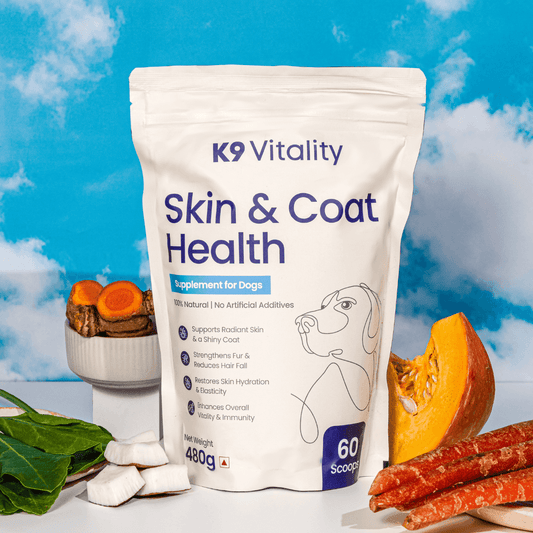
How to Identify the Type of Dog Skin Rash Your Pet Has: A Complete Guide for Pet Parents
Share
Do You Know How to Identify the Type of Dog Skin Rash Your Pet Has?
You notice your dog scratching more than usual. Maybe there is a red patch on the belly. Or flaky skin near the ears. Could it be fleas, allergies, or something more serious?
If you are not sure, you are not alone.
Skin rashes are common in dogs and often confusing. They can look similar and overlap in symptoms.
Here is the problem. Treating the wrong type of rash can make things worse. The wrong product or delayed treatment can turn a mild case into a serious condition.
That is why K9 Vitality created this expert guide to help you:
- Decode different types of skin rashes in dogs
- Understand what causes them
- Learn how to treat and prevent them safely
- Recognize when it is time to see the vet
If your dog has had skin issues, or you want to be prepared, this guide gives you clear, practical steps.
Why Correct Identification Matters

Dog skin rashes are a signal that something deeper is wrong. It could be an allergy, an infection, or an autoimmune issue.
Misidentifying the cause can lead to:
- Delayed healing
- More discomfort for your dog
- Unnecessary medication or side effects
- Higher vet bills due to complications
Identify the rash type accurately to help your dog feel better faster.
The Most Common Dog Skin Rashes
Here are the types you will see most often, how to recognize them, and what causes each one.
1. Allergic Dermatitis, Environmental or Food
Visual signs
- Red, irritated skin
- Licking or chewing paws
- Bald spots around the armpits, belly, and face
- Inflamed ears
Common triggers
- Grass, pollen, dust mites
- Certain proteins, chicken, beef, and dairy
- Grooming products or detergents
Treatment strategy
- Elimination diets or allergy testing
- Hypoallergenic diets and products
- Anti-itch medications prescribed by a vet
2. Fungal Infections, Yeast or Ringworm
Visual signs
- Greasy, smelly skin
- Circular hair loss, ringworm
- Flaky or darkened skin, especially in folds or ears
Causes
- Yeast overgrowth in moist environments
- Fungal spores, often contagious
Treatment strategy
- Antifungal shampoos and topicals
- Prescription antifungal medications
- Keep skin clean and dry
3. Parasitic Dermatitis, Fleas, Mites, Ticks
Visual signs
- Tiny red bumps or scabs
- Intense scratching or biting
- Hair loss around tail, neck, or back
Causes
- Fleas, mange mites, tick bites
Treatment strategy
- Oral or topical parasite control
- Deep clean bedding and environment
- Ongoing prevention program
4. Bacterial Skin Infections, Pyoderma
Visual signs
- Pus filled bumps
- Redness, oozing, or crusting
- Foul smelling lesions
Causes
- Secondary to allergy, trauma, or moisture
- Bacterial overgrowth, commonly staph
Treatment strategy
- Topical or oral antibiotics
- Find and treat the root cause
5. Hot Spots, Acute Moist Dermatitis
Visual signs
- Wet, inflamed, rapidly growing sore
- Painful to the touch
- Frequent licking or chewing
Causes
- Allergies, fleas, anxiety, or minor wounds
Treatment strategy
- Shave fur around the sore
- Cleanse and dry the area
- Use topical or oral medications as directed by your vet
Location and Behavior, Key Clues

Where the rash appears and how your dog behaves can point to the cause.
By body area
- Paws and ears, yeast or food allergies
- Belly and underarms, contact or seasonal allergies
- Tail base and back, flea allergy dermatitis
- Face and neck, food sensitivities or reaction to grooming products
By behavior
- Head shaking, possible ear infection or yeast
- Scooting, possible anal gland irritation or allergy
- Obsessive licking, often allergy or fungal related
When to Call the Vet
Some mild rashes clear with home care. Others need professional help.
See your vet if
- The rash spreads or worsens quickly
- There is pus, bleeding, or foul odor
- Your dog seems lethargic, depressed, or in pain
- Symptoms persist more than 5 to 7 days
Your vet may run tests such as skin scrapings, allergy panels, or biopsies.
Prevent Recurring Rashes
Prevention focuses on skin barrier strength and smart care.
Hygiene and grooming
- Regular baths with vet recommended shampoo
- Thorough drying, especially skin folds and ears
- Clean bedding, collars, and grooming tools
Nutrition
- Feed high quality food with essential fatty acids
- Avoid common allergens, consult your vet
Parasite control
- Year round flea and tick protection
- Clean indoor and outdoor areas regularly
Holistic Support for Skin Wellness
Rashes are often a symptom. Address health, environment, diet, and stress for lasting relief.
- Immune support, helps defend against pathogens
- Inflammation reduction, soothes the skin and prevents damage
- Skin barrier strength, limits allergen and fungus penetration
The Long Term Solution, Support From the Inside
After the visible rash clears, support the skin from within.
Try the K9 Vitality Skin and Coat Health Supplement. It is designed to:
Key benefits
- Rebuild and reinforce the skin barrier
- Reduce rashes related to inflammation or allergies
- Nourish the coat to reduce dryness, shedding, and dullness
- Support immunity against fungi, bacteria, and parasites
Why it works
- Omega 3 and 6 fatty acids, calm inflammation and hydrate skin
- Biotin and zinc, support skin cell turnover and coat strength
- Natural antioxidants, help limit skin damage
Use daily as part of your dog’s routine. Give protection inside and out. Explore here, K9 Vitality Skin and Coat Health Supplement.
K9 Vitality Is Here to Help You and Your Dog
Your dog cannot tell you what is wrong. Their skin can. When you read the signs and act with the right steps, you help your dog feel better and stay well.
Identifying rash types helps you solve the problem today and improve long term comfort and health.
K9 Vitality guides you with:
- Clear information
- Trusted solutions
- Real results
Take charge of your dog’s skin health today. Every scratch tells a story, and now you know how to respond.
Better skin. Stronger immunity. Happier dogs with K9 Vitality.






